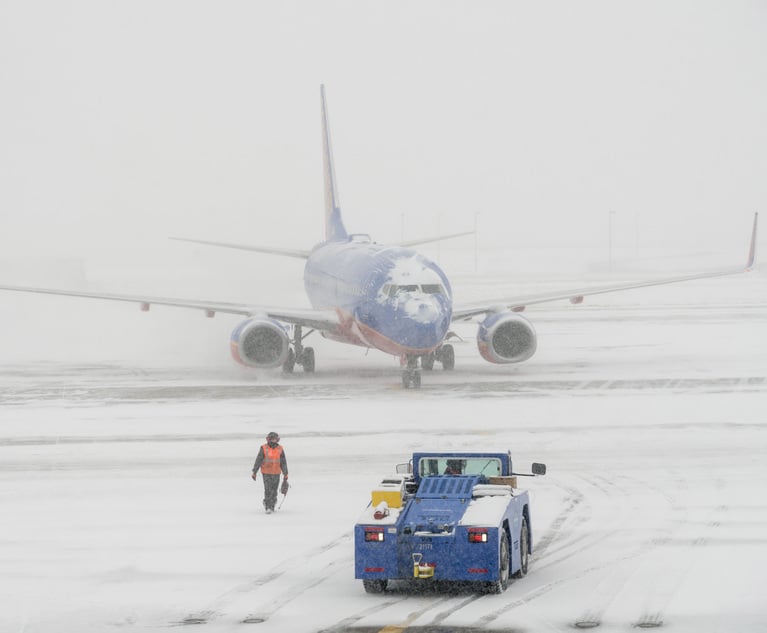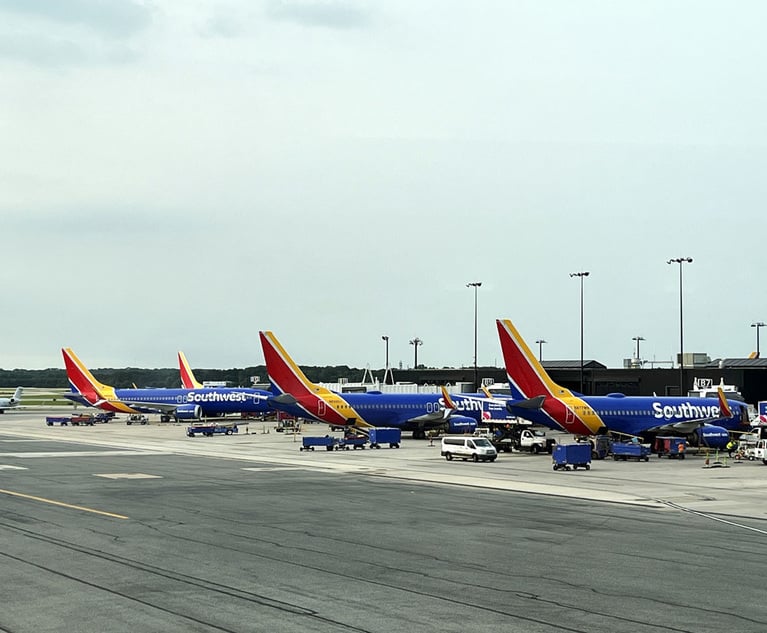 Credit: Kirill Gorlov/Adobe Stock
Credit: Kirill Gorlov/Adobe Stock Charter Flight Operators Seek Tougher Enforcement Against Repeat Violators
The darker side of the chartered jet business has involved Hollywood celebrities and several sports teams, and is behind a handful of fatal crashes, such as a business jet that skidded off a South Carolina runway with malfunctioning brakes in 2018.
December 29, 2022 at 10:45 AM
5 minute read
TransportationWithin months of a 2008 fatal plane crash that killed five, federal authorities revoked the license of the Oklahoma company that arranged the charter flight for allegedly doing so illegally.
But Interstate Helicopters Inc. won back its certificate to fly commercially early the next year and has kept it despite multiple subsequent violations of aviation regulations, a guilty plea to federal criminal charges and alleged illegal charter flights prompting a proposed $617,100 fine last year, according to public records.
James Johnson, the owner of Interstate Helicopters, blamed confusing regulations and criticized the Federal Aviation Administration for targeting him. Instead of contesting charges, he said in an interview that he agreed to settle on several occasions to avoid hefty legal fees.
Interstate Helicopters' case illustrates the challenges faced by the FAA. Despite a crackdown in recent years that has resulted in a surge of civil enforcement and criminal cases, legal operators say tougher penalties are needed to rein in a widespread problem that has marred the industry's reputation.
"The penalties need to be stiff and they need to be expedient," said Alan Stephens, vice president of regulatory affairs at the National Air Transportation Association, a leading trade group for the charter industry.
The darker side of the chartered jet business has involved Hollywood celebrities and several sports teams, and is behind a handful of fatal crashes, such as a business jet that skidded off a South Carolina runway with malfunctioning brakes in 2018, Bloomberg News reported last month.
NATA, which represents thousands of airport businesses, including many of the biggest charter companies, is pushing FAA to make it easier for potential clients to determine whether operators are legitimate. It also plans on asking Congress for measures to toughen enforcement, Stephens said.
Partially at NATA's urging, the FAA in recent years created a special investigative team aimed at illicit charter operators, pursued dozens of enforcement cases with millions of dollars in proposed fines, and held numerous public forums to educate industry groups on the rules. It has also created a website with warnings for consumers.
But those investigative and educational efforts haven't stopped illegal charter operators from flying, according to FAA inspectors, former agency lawyers, aviation industry officials and public records.
Complex and Time-Consuming
Regulators face challenges because putting together an enforcement case is complex and time-consuming, which can be difficult for already overburdened FAA staff, said two agency safety inspectors who asked not to be identified discussing the issue.
The agency has about 3,900 safety inspectors, though not all of them focus on charter operations. More than three-quarters of FAA managers who oversee inspectors monitoring charters reported their offices were understaffed in a 2021 Transportation Department Inspector General report.
"It has been historically difficult to ferret out illegal operations and prosecute them the way they should be prosecuted," said Loretta Alkalay, the former FAA eastern regional counsel and an adjunct professor at Vaughn College of Aeronautics & Technology.
The FAA defended its efforts to police the air-charter world in an emailed statement, citing the increase in enforcement cases and other actions it has taken to educate the industry and consumers.
"We work aggressively to identify and shut down rogue operators and help passengers ensure the company they hire is legitimate," the agency said.
The FAA relies on the Department of Justice to prosecute and collect fines from violators of aviation statutes in major cases. But federal prosecutors dealing with violent and other serious crimes don't always see the urgency of pursuing civil cases alleging violations of an aviation statute, said J.E. Murdock, a consultant and blogger who formerly served as FAA's chief counsel.
"It's a function of how busy these people are," Murdock said of U.S. attorney's offices around the country.
The Justice Department didn't respond to emails seeking comment.
Maze of Problems
Interstate Helicopters' legal troubles started with the crash of a Cessna 500 business jet two minutes after takeoff from Wiley Post Airport near Oklahoma City on March 4, 2008, which killed three passengers and two pilots.
While a collision with pelicans was identified as the cause of the accident, the National Transportation Safety Board and FAA found a maze of compliance problems, according to accident reports. Interstate Helicopters was authorized to carry passengers for hire, but only on helicopters — not on the jet that crashed.
The plane hadn't been maintained under the rigorous requirements for charter operations, the investigators said. Neither pilot was qualified to fly the plane for hire, the NTSB determined. The captain, who wasn't subject to the normal drug testing required under charter rules, had taken a muscle relaxant that the FAA prohibits while flying, according to the NTSB.
The local truck-engine manufacturer that paid for the ill-fated flight for the three executives who died, United Engines, had hired Interstate Helicopters for at least 19 other trips, NTSB said. United Engines, now a subsidiary of Kirby Corp., told investigators at the time they didn't realize the operator had violated any laws.
Interstate Helicopters' Johnson described the flight arrangement as a lease that he thought was legal at the time.
The FAA didn't comment specifically on Interstate Helicopters, but said the sanctions it seeks are based on "the facts of the case" and a company's violation history.
Jim Hensley, owner of rival America Jet Charter Inc., told NTSB investigators in 2008 he believed there have been problems with illegal charters for years. He still believes that to be the case.
"The only way I see it changing is giving the FAA more teeth to enforce the rules," Hensley said in a recent interview.
Alan Levin reports for Bloomberg News.
NOT FOR REPRINT
© 2025 ALM Global, LLC, All Rights Reserved. Request academic re-use from www.copyright.com. All other uses, submit a request to [email protected]. For more information visit Asset & Logo Licensing.
You Might Like
View All
Southwest Airlines Faces $100M Class Action Over Pay Periods

Rogge Dunn Represents Florida Trucking Firm in Civil RICO Suit Against Worldwide Express
4 minute read
Fowler White Burnett Opens Jacksonville Office Focused on Transportation Practice
3 minute readTrending Stories
- 1Data Disposition—Conquering the Seemingly Unscalable Mountain
- 2Who Are the Judges Assigned to Challenges to Trump’s Birthright Citizenship Order?
- 3Litigators of the Week: A Directed Verdict Win for Cisco in a West Texas Patent Case
- 4Litigator of the Week Runners-Up and Shout-Outs
- 5Womble Bond Becomes First Firm in UK to Roll Out AI Tool Firmwide
Who Got The Work
J. Brugh Lower of Gibbons has entered an appearance for industrial equipment supplier Devco Corporation in a pending trademark infringement lawsuit. The suit, accusing the defendant of selling knock-off Graco products, was filed Dec. 18 in New Jersey District Court by Rivkin Radler on behalf of Graco Inc. and Graco Minnesota. The case, assigned to U.S. District Judge Zahid N. Quraishi, is 3:24-cv-11294, Graco Inc. et al v. Devco Corporation.
Who Got The Work
Rebecca Maller-Stein and Kent A. Yalowitz of Arnold & Porter Kaye Scholer have entered their appearances for Hanaco Venture Capital and its executives, Lior Prosor and David Frankel, in a pending securities lawsuit. The action, filed on Dec. 24 in New York Southern District Court by Zell, Aron & Co. on behalf of Goldeneye Advisors, accuses the defendants of negligently and fraudulently managing the plaintiff's $1 million investment. The case, assigned to U.S. District Judge Vernon S. Broderick, is 1:24-cv-09918, Goldeneye Advisors, LLC v. Hanaco Venture Capital, Ltd. et al.
Who Got The Work
Attorneys from A&O Shearman has stepped in as defense counsel for Toronto-Dominion Bank and other defendants in a pending securities class action. The suit, filed Dec. 11 in New York Southern District Court by Bleichmar Fonti & Auld, accuses the defendants of concealing the bank's 'pervasive' deficiencies in regards to its compliance with the Bank Secrecy Act and the quality of its anti-money laundering controls. The case, assigned to U.S. District Judge Arun Subramanian, is 1:24-cv-09445, Gonzalez v. The Toronto-Dominion Bank et al.
Who Got The Work
Crown Castle International, a Pennsylvania company providing shared communications infrastructure, has turned to Luke D. Wolf of Gordon Rees Scully Mansukhani to fend off a pending breach-of-contract lawsuit. The court action, filed Nov. 25 in Michigan Eastern District Court by Hooper Hathaway PC on behalf of The Town Residences LLC, accuses Crown Castle of failing to transfer approximately $30,000 in utility payments from T-Mobile in breach of a roof-top lease and assignment agreement. The case, assigned to U.S. District Judge Susan K. Declercq, is 2:24-cv-13131, The Town Residences LLC v. T-Mobile US, Inc. et al.
Who Got The Work
Wilfred P. Coronato and Daniel M. Schwartz of McCarter & English have stepped in as defense counsel to Electrolux Home Products Inc. in a pending product liability lawsuit. The court action, filed Nov. 26 in New York Eastern District Court by Poulos Lopiccolo PC and Nagel Rice LLP on behalf of David Stern, alleges that the defendant's refrigerators’ drawers and shelving repeatedly break and fall apart within months after purchase. The case, assigned to U.S. District Judge Joan M. Azrack, is 2:24-cv-08204, Stern v. Electrolux Home Products, Inc.
Featured Firms
Law Offices of Gary Martin Hays & Associates, P.C.
(470) 294-1674
Law Offices of Mark E. Salomone
(857) 444-6468
Smith & Hassler
(713) 739-1250







